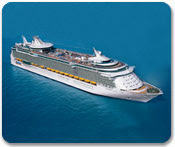In 1839 Samuel Cunard and his British North American Royal Mail Steam Packet Company, started the first mail service between Liverpool and Boston. About one year later Cunard decided he wanted a share in the transatlantic passenger trade and Cunard Line was born. Cunard Line’s Brittania set sail on its first passenger voyage on July 4th, 1840 from England. There were 63 passengers on the inaugural sailing including Samuel Cunard and his daughter. The ship successfully sailed into Boston Harbor 13 days later and from this humble beginning the cruise business was born. Cunard Line grew throughout the latter part of the 19th century with regularly scheduled service to New York.
Another cruise line that was formed at the end of the 19th century was Holland America. Founded in 1873, under the name Netherlands-America Steamship Company, a shipping and passenger line, Holland America sailed its first ship, the original Rotterdam, on a 15-day maiden voyage from the Netherlands to New York City. The Rotterdam not only carried passengers, she also transported tons of cargo including flower bulbs, herring and gin.
By the early 20th century the concept of the superliner was developed and the Lusitania and the Mauretania took to the sea. These two 30,000 ton liners with propulsion engines were designed to minimize the discomfort of ocean travel through elegant accommodations and planned activities. These two ships started the tradition of dressing for dinner and advertised the romance of the voyage. Traveling across the North Atlantic now took only five or six days instead of 13 or 14 days on the old steam ships. The early 20th century also brought in other European lines, including the German Hamburg American Line and the French Line.
The introduction of these new ships also brought with them a class of service system which was broken down to 1st class, 2nd class and steerage. First class passengers were often the idle rich, wealthy business barons, highly paid entertainers and the like. Second class passengers were mostly white collar workers and steerage was offered to the relatively poor.
The years between 1920 and 1940 were considered the most glamorous years for transatlantic passenger ships. During the 1930’s ship size increased to 70,000 – 80,000 gross tonnage and French Line’s Normandie and Cunard-White Star Line’s Queen Mary and Queen Elizabeth came into service. America’s first entry was the S.S. United States in 1952, and was the fastest liner at that time. Ships had now become more like floating hotels and catered to the rich and famous with lavish accommodations, elegant food and on-board activities.
The war times were tough on the cruise industry. World War I and II interrupted the building of new cruise ships, and many of the older liners were used as troop transports. Transatlantic sailings were also put on hold until World War II was over. After the war ship building picked up again, but this time in addition to the luxurious amenities, ships were designed according to specifications for possible conversion into troop carriers. 1958 brought on the end of the transatlantic business for many ocean liners with the increase in air travel and the first non-stop flight to Europe. Many passenger ships were sold and a number of lines went bankrupt.
The first modern cruise line was establish in the 1960s by Ted Arison and Knut Kloster who offered fair weather cruising to Bermuda, the Bahamas and the Caribbean under the name of Norwegian Caribbean Line which later evolved to Norwegian Cruise Line. Hence a new cruise line image was born, one that offered fun in the sun for every class of people. Soon to follow were Royal Caribbean, Princess Cruises and Carnival Cruise Line.
Following the modern cruise lines debut in the Caribbean, world cruising opened up to include Alaska, Hawaii, the South Pacific, Orient & Europe. As early as the 1960s Cunard’s Queen Elizabeth 2 and Holland America Line’s Rotterdam V started sailing annual 3 month World Cruises. Starting in the 1970s cruise ships were being designed with modern innovations in mind making them more stable, adding more public rooms and providing more stateroom amenities.
The 21st century cruising experience now includes multiple dining options, state of the art health and fitness venues, Las Vegas and Broadway-style shows, world-wide itineraries, activities for both the young and old, and so much more!
With so many cruise lines and so many beautiful ships currently sailing or coming into service, its time for you to “evolve” into a modern day cruiser. Your Cruise Specialist is ready to bring you to the next level in cruising.
Don't live a little, live on fire
14 years ago


